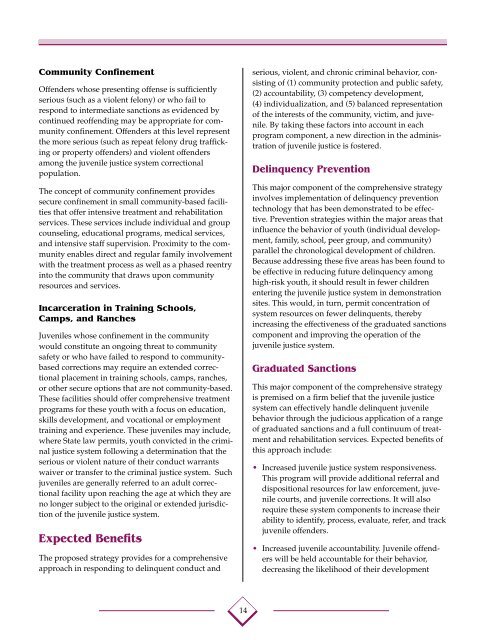uide for Implementing the Comprehensive Strategy for Serious ...
uide for Implementing the Comprehensive Strategy for Serious ...
uide for Implementing the Comprehensive Strategy for Serious ...
You also want an ePaper? Increase the reach of your titles
YUMPU automatically turns print PDFs into web optimized ePapers that Google loves.
Community Confinement<br />
Offenders whose presenting offense is sufficiently<br />
serious (such as a violent felony) or who fail to<br />
respond to intermediate sanctions as evidenced by<br />
continued reoffending may be appropriate <strong>for</strong> community<br />
confinement. Offenders at this level represent<br />
<strong>the</strong> more serious (such as repeat felony drug trafficking<br />
or property offenders) and violent offenders<br />
among <strong>the</strong> juvenile justice system correctional<br />
population.<br />
The concept of community confinement provides<br />
secure confinement in small community-based facilities<br />
that offer intensive treatment and rehabilitation<br />
services. These services include individual and group<br />
counseling, educational programs, medical services,<br />
and intensive staff supervision. Proximity to <strong>the</strong> community<br />
enables direct and regular family involvement<br />
with <strong>the</strong> treatment process as well as a phased reentry<br />
into <strong>the</strong> community that draws upon community<br />
resources and services.<br />
Incarceration in Training Schools,<br />
Camps, and Ranches<br />
Juveniles whose confinement in <strong>the</strong> community<br />
would constitute an ongoing threat to community<br />
safety or who have failed to respond to communitybased<br />
corrections may require an extended correctional<br />
placement in training schools, camps, ranches,<br />
or o<strong>the</strong>r secure options that are not community-based.<br />
These facilities should offer comprehensive treatment<br />
programs <strong>for</strong> <strong>the</strong>se youth with a focus on education,<br />
skills development, and vocational or employment<br />
training and experience. These juveniles may include,<br />
where State law permits, youth convicted in <strong>the</strong> criminal<br />
justice system following a determination that <strong>the</strong><br />
serious or violent nature of <strong>the</strong>ir conduct warrants<br />
waiver or transfer to <strong>the</strong> criminal justice system. Such<br />
juveniles are generally referred to an adult correctional<br />
facility upon reaching <strong>the</strong> age at which <strong>the</strong>y are<br />
no longer subject to <strong>the</strong> original or extended jurisdiction<br />
of <strong>the</strong> juvenile justice system.<br />
Expected Benefits<br />
The proposed strategy provides <strong>for</strong> a comprehensive<br />
approach in responding to delinquent conduct and<br />
14<br />
serious, violent, and chronic criminal behavior, consisting<br />
of (1) community protection and public safety,<br />
(2) accountability, (3) competency development,<br />
(4) individualization, and (5) balanced representation<br />
of <strong>the</strong> interests of <strong>the</strong> community, victim, and juvenile.<br />
By taking <strong>the</strong>se factors into account in each<br />
program component, a new direction in <strong>the</strong> administration<br />
of juvenile justice is fostered.<br />
Delinquency Prevention<br />
This major component of <strong>the</strong> comprehensive strategy<br />
involves implementation of delinquency prevention<br />
technology that has been demonstrated to be effective.<br />
Prevention strategies within <strong>the</strong> major areas that<br />
influence <strong>the</strong> behavior of youth (individual development,<br />
family, school, peer group, and community)<br />
parallel <strong>the</strong> chronological development of children.<br />
Because addressing <strong>the</strong>se five areas has been found to<br />
be effective in reducing future delinquency among<br />
high-risk youth, it should result in fewer children<br />
entering <strong>the</strong> juvenile justice system in demonstration<br />
sites. This would, in turn, permit concentration of<br />
system resources on fewer delinquents, <strong>the</strong>reby<br />
increasing <strong>the</strong> effectiveness of <strong>the</strong> graduated sanctions<br />
component and improving <strong>the</strong> operation of <strong>the</strong><br />
juvenile justice system.<br />
Graduated Sanctions<br />
This major component of <strong>the</strong> comprehensive strategy<br />
is premised on a firm belief that <strong>the</strong> juvenile justice<br />
system can effectively handle delinquent juvenile<br />
behavior through <strong>the</strong> judicious application of a range<br />
of graduated sanctions and a full continuum of treatment<br />
and rehabilitation services. Expected benefits of<br />
this approach include:<br />
• Increased juvenile justice system responsiveness.<br />
This program will provide additional referral and<br />
dispositional resources <strong>for</strong> law en<strong>for</strong>cement, juvenile<br />
courts, and juvenile corrections. It will also<br />
require <strong>the</strong>se system components to increase <strong>the</strong>ir<br />
ability to identify, process, evaluate, refer, and track<br />
juvenile offenders.<br />
• Increased juvenile accountability. Juvenile offenders<br />
will be held accountable <strong>for</strong> <strong>the</strong>ir behavior,<br />
decreasing <strong>the</strong> likelihood of <strong>the</strong>ir development

















